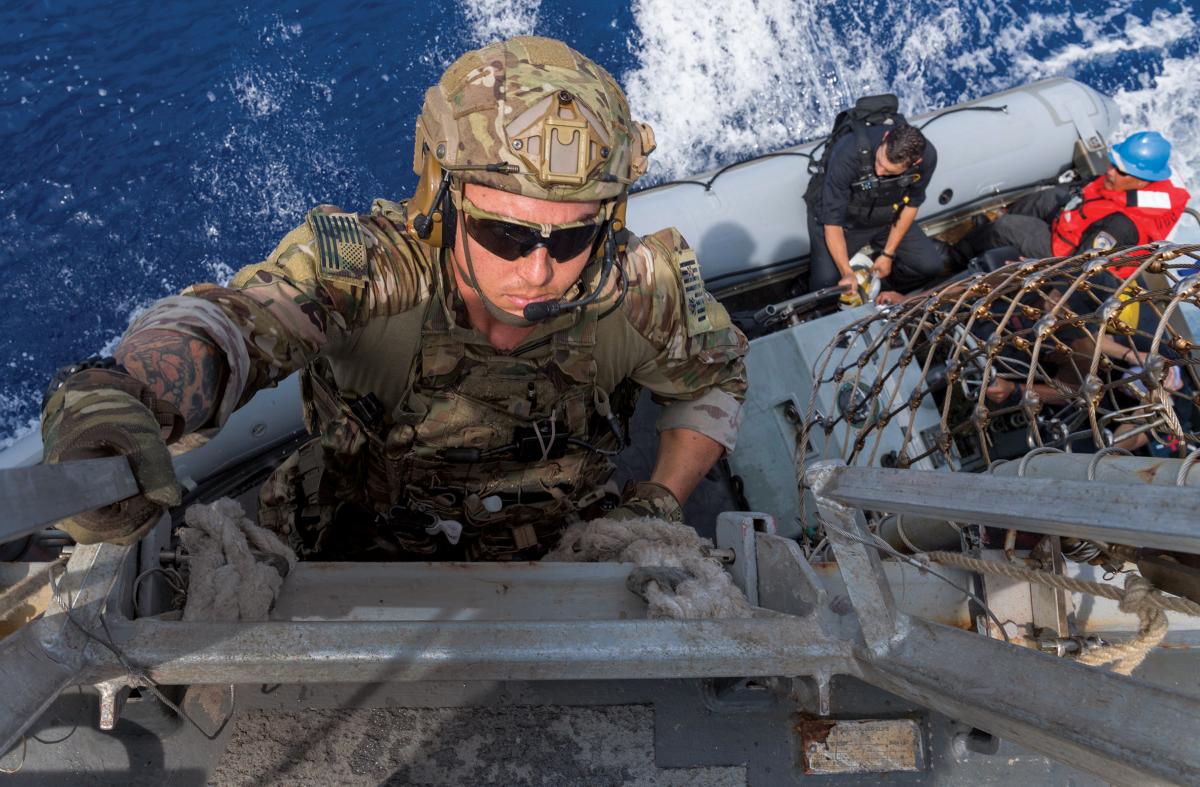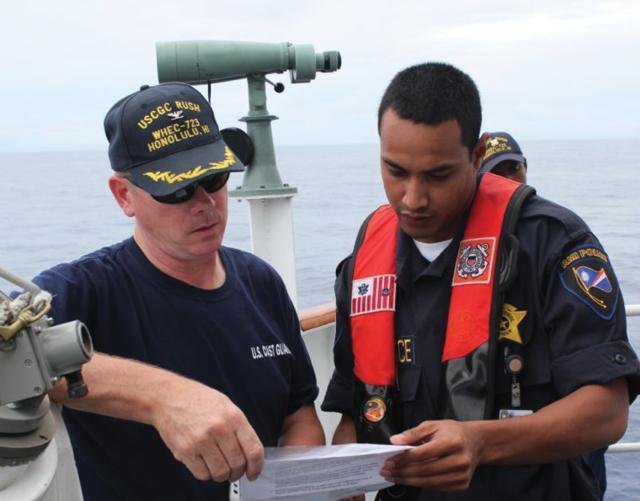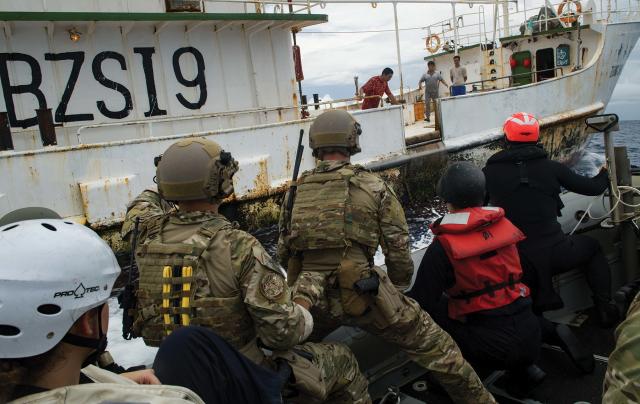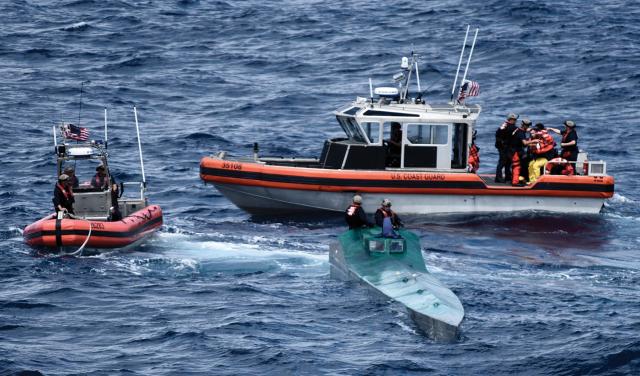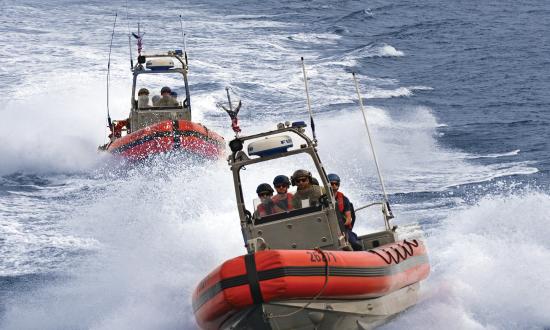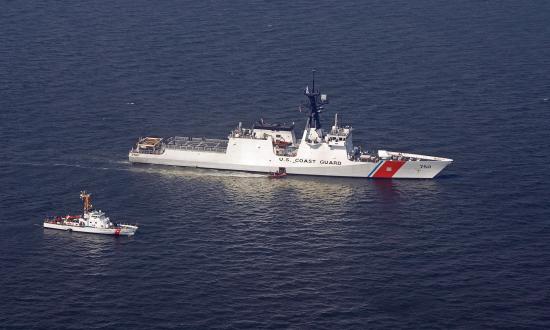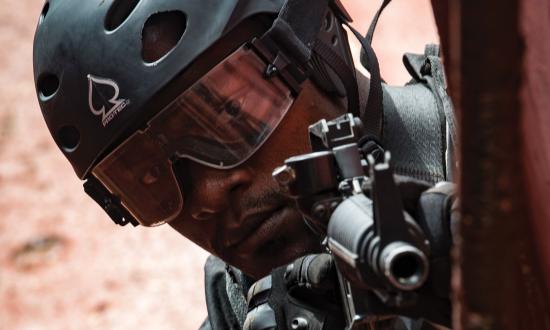The Indo-Pacific is at the center of the current era of great power competition. This region, comprising the western Pacific and Oceania, is rife with complex security challenges. In particular, China is increasing its military and economic predatory presence, undermining the rules-based international order that has provided relative stability since the end of World War II.1 While Chinese influence grows, the United States simultaneously contends with rising transnational criminal activity throughout the region. To combat these challenges, the U.S. Coast Guard must deploy law enforcement detachments (LEDets) to the region to operate and train alongside allies and Indo-Pacific nations as their security partner in defense of their maritime sovereignty.
Indo-Pacific Challenges
Chinese predatory influence in the Indo-Pacific is growing. In 2019, a Chinese government-backed company attempted to lease the entire island of Tulagi; large Chinese fishing fleets operated illegally in Indo-Pacific nations’ exclusive economic zones (EEZs) under protection of the China Coast Guard; and China expressed direct interest in developing a military base on the island of Vanuatu.2 Further, China relies heavily on its coast guard, along with its paramilitary maritime militia, to project power and assert its maritime claims.3 China engages in gray-zone tactics that blur civilian and military forces and remain under the threshold of a military response.4 These tactics enable China to make excessive maritime sovereignty claims and encroach on the territorial waters of South China Sea nations, resulting in degraded regional stability.
Contending with rising transnational criminal activity throughout the Indo-Pacific is another serious concern for the United States. A recent United Nations report highlighted how transnational criminal organizations (TCOs) are expanding aggressively in Southeast Asia, generating hundreds of billions of dollars in illicit revenue, and are a destabilizing force in the region.5 The TCOs have no regard for boundaries and are taking advantage of the region’s size, minimal U.S. and allied nation interdiction efforts, and Indo-Pacific nations that lack the organic ability to maintain maritime sovereignty and security.
Unique and Specialized Capabilities
Highly trained and equipped LEDets project Coast Guard capabilities and authorities from Department of Defense (DoD) and allied resources at minimal cost to the U.S. government. They are the ideal force to deploy while engaging in this geostrategic competition. LEDets can rapidly deploy to support myriad maritime law enforcement operations, including on the high seas of the Indo-Pacific. Moreover, the primary duty of LEDets is to conduct maritime law enforcement, whereas traditional Coast Guard assets balance numerous missions and conduct law enforcement operations as a collateral duty.
LEDets integrate seamlessly with elements from all U.S. military branches, allies, and partner nations, which enhances expertise across service and international boundaries and provides for improved mission execution. Primarily deploying in support of U.S. Southern Command priorities, LEDets operate under Joint Interagency Task Force (JIATF) South to execute noncompliant countertrafficking interdictions. After supporting these operations for 40 years, LEDets have perfected the required expertise and mission familiarity to confront challenges in the Indo-Pacific and reinforce the United States’ role the region.
Promoting a Rules-Based International Order
During the 2020 State of the Coast Guard address, Commandant Admiral Karl Schultz indicated that the service will continue to promote a rules-based order, build capacity, and affirm the nation’s positive and enduring role in the Indo-Pacific.6 In 2019, two Coast Guard cutters partnered with allied navies and Indo-Pacific nations to conduct maritime law enforcement operations in support of Operation Aiga, and Admiral Schultz stated he intends to support this operation again in 2020.7 A continuing Coast Guard presence is beneficial, but its full potential is not realized unless LEDets deploy alongside traditional Coast Guard assets to provide superior law enforcement expertise.
Further, to advance this rules-based order, the Coast Guard director of international affairs and foreign policy should develop binational or multinational agreements that enable LEDet employment from allied vessels operating in the Indo-Pacific.8 One of the closest U.S. allies, Australia, and closest partners, New Zealand, already have developed interoperability with traditional Coast Guard and Indo-Pacific nation assets, are well-suited to embark LEDets, and have demonstrated a commitment to enforce this rules-based international order.9
Australia’s Pacific Patrol Boat Program led the way for Indo-Pacific nations to bolster their security and EEZ resources.10 These boats enable the nations to effectively patrol their waters and support law enforcement operations. Many Indo-Pacific nations already have robust yet underused agreements with the U.S. Coast Guard, including shiprider provisions that enable combined maritime law enforcement operations. If the existing agreements become multinational involving the United States, Australia or New Zealand, and another Indo-Pacific nation, the combined force will promote maritime sovereignty, enhance regional capabilities, and solidify the United States’ position in the new power competition.
In addition, Rear Admiral Kenneth R. Whitesell,
U.S. Pacific Fleet Deputy Commander, recognizes that some Indo-Pacific nations have compacts of association with the United States that the U.S. military should “square up to.”11 This requires continuous engagement and an investment that will begin to reverse the perception that
Indo-Pacific nations “have been tacked on to the end” of the United States’ greater Indo-Pacific strategy.12 The United States must do more than warn Indo-Pacific nations of China’s debt-trap diplomacy tactics; it must help them promote a rules-based order through fisheries regulation support and capacity-building activities. LEDets are the best tool for the United States to square up to these agreements and help secure regional security through transparent engagement while advancing U.S. interests.
Bolstering Current Initiatives and Ops
JIATF West, U.S. Indo-Pacific Command’s (IndoPaCom’s) executive agent for DoD support to law enforcement, is tasked to combat TCOs in the Indo-Asia-Pacific theater. JIATF West does not have tactical control of any maritime assets to execute its mission, making it difficult to serve as IndoPaCom’s executive agent for counterdrug activities and provide support to Indo-Pacific law enforcement agencies.
LEDets are the Coast Guard’s experts in maritime countertrafficking operations, are familiar with working for interagency task forces, and provide direct operational support to foreign partners under host-nation authority and jurisdiction. If results of past LEDet operations are any indication of future success, their ability to aggressively combat TCOs and malign influences in the Indo-Pacific region should be immediate and tangible. Also, LEDets would provide direct operation support to JIATF West and IndoPaCom, addressing its top identified trends and challenges: the economic, political, and military rise of China, coupled with Chinese military modernization and coercive actions, and the prevalence of transnational illicit activities.13
The U.S. Coast Guard and Navy currently partner to execute the Oceania Maritime Security Initiative (OMSI), a DoD program focused on combating transnational crimes, enforcing fisheries laws, and enhancing security throughout the Indo-Pacific. OMSI promotes regional economic and environmental stability and enables Indo-Pacific nations to defend their sovereignty. The superior working relationship between LEDets and Navy warships to conduct joint operations enforcing illegal, unregulated, and unreported (IUU) fisheries has paved the way for additional joint operations in the region. However, operational days in support of OMSI have declined by at least 50 percent each year since 2017. In turn, the joint Coast Guard–Navy regional impact has suffered, negatively affecting U.S. ability to counter China’s aggressive and irresponsible tactics to protect its fishing fleets operating in disputed or sovereign waters of other nations.
Navy warships with embarked LEDets jointly and persistently operating in the region, coupled with an expanded concept of operations, could better contest Chinese predatory influence. China’s massive fishing fleet, supported by various Chinese agencies, is a major contributor to the IUU problem.14 Contesting Chinese influence occurs through a calculated increase in OMSI operations, international engagements coincident with other regional missions, and combined operations using provisions of already established agreements with Indo-Pacific nations. As Admiral Schultz stated, and a Stimson Center report reiterated, “to stop IUU fishing we must increase accountability and help . . . nations improve their maritime domain awareness.” To do so, additional LEDets are required in the region.15
Indo-Pacific nations, faced with growing challenges from Chinese maritime aggression, are actively expanding their military capabilities.16 The U.S. Army recognizes this and engages through Pacific Pathways, an exercise series that generates goodwill and promotes a free and open Indo-Pacific. The Army has established a collaborative framework with Australia, New Zealand, and France and will be training alongside nine Indo-Pacific nations.17 This training is invaluable, proves that the United Stated is willing to square up to its agreements, and ensures that Indo-Pacific nations continue to view the United States as their security partner of choice.
Because of the capacity of many Indo-Pacific nations, the Army can deploy only 10–15 soldiers to support these efforts.18 Coincidentally, the Army’s numbers closely mirror the size of a LEDet on the small side and that of an Adaptive Force Package (AFP), composed of LEDet and other U.S. Coast Guard Deployed Specialized Forces members, on the larger side. Where the Army lacks expertise (maritime law enforcement, counterdrug operations, and sensitive-site exploitation), LEDets can immediately fill proficiency gaps and provide critical training as Indo-Pacific nations build and modernize their capabilities. Furthermore, many Indo-Pacific coast guards have dual military and law enforcement authorities on par with those of the U.S. Coast Guard.
A Way Forward with LEDets
Vice Admiral Linda L. Fagan, Coast Guard Pacific Area Commander, said “the challenge is there’s just not a lot of us [USCG assets] to go around so it’s making sure the capacity that we do have to dedicate to the region are applied for best effect.”19 LEDets can provide the desired effect, have the skills to promote interoperability, enhance security, and counter maritime aggression, and do so at minimal cost with proven returns. LEDets straddle the line between military and law enforcement operations and bring white-hull influence to a gray zone that is increasingly difficult to operate in; China has clearly recognized this and has taken full advantage throughout the region.
The deployment of national security cutters to the Indo-Pacific and South China Sea and the joint U.S. Coast Guard–Navy Taiwan Strait transits demonstrate a commitment to maintaining a free and open Indo-Pacific. Lyle Morris, an analyst with the RAND Corporation, believes it signals a new level of interoperability between the two Sea Services.20 However, Coast Guard and Navy interoperability has existed for more than 30 years in the form of LEDets deploying on board Navy ships to conduct law enforcement operations and LEDets deploying alongside naval special warfare units to train partner nation forces. What is missing from these deployments is LEDets certified to conduct fisheries and noncompliant boardings, enforce U.N. Security Council resolutions, and provide law enforcement training to Indo-Pacific forces to enhance interoperability.
The DoD’s Assessment on U.S. Defense Implications of China’s Expanding Global Access identifies a strategic priority that LEDets are predisposed to execute: strengthening allies and partners to generate robust networks that can advance shared interests.21 LEDet deployments in support of defense readiness and capacity building
activities strengthen the sovereignty of Indo-Pacific
nations and counter China’s efforts to become the next great Indo-Pacific power. The Coast Guard must take an offensive posture, paired with proactive engagement with domestic and international partners, to support this priority.
Ensuring the U.S. Indo-Pacific Position
The U.S. Coast Guard Western Hemisphere Strategy recognizes key tenets at the strategic, operational, and tactical levels that have merit in the Indo-Pacific region:
- The need to review and pursue measures to strengthen bilateral agreements, including the opportunity to conduct combined operations
- The importance of evaluating the effectiveness of deploying interdiction assets such as LEDets to nontraditional platforms and/or locations that are experiencing an increasing presence of transnational organized crime activity and malign influence driven by state and nonstate actors
- The unique and specialized capabilities of LEDets22
Applying these tenets to the Indo-Pacific region through LEDet deployments would truly enable the United States to contest China’s malign influence. To further refine the Coast Guard’s approach in the Indo-Pacific, a Coast Guard strategy should be developed.
Many of the critical components of the Western Hemisphere Strategy align with principles from the 2019 DoD Indo-Pacific Strategy Report. The report’s key principles are preparedness, partnerships, and promotion of a networked region—all areas where LEDets are uniquely positioned to support mission execution.23 LEDets are able to integrate with forward-postured forces, provide additional authorities and broader skillsets, and have proved to be highly effective, whether on board Navy ships and allied vessels or when conducting combined operations from partner nations’ shores and vessels. LEDets serve as a meaningful force multiplier to achieve peace and promote deterrence and are an exceptional tool to reinforce the U.S. commitment to alliances and partnerships in the Indo-Pacific region.
The United States is a Pacific nation and must fully engage in the Indo-Pacific region. The Indo-Pacific Strategy Report demonstrates that succeeding in this region requires an integrated effort between DoD, other
U.S. government departments and agencies, and regional allies and partners to uphold a rules-based order that ensures security and prosperity.24 To quote then–Secretary of Defense James Mattis, “The U.S. offers strategic partnerships, not strategic dependence.”25 The Coast Guard has a record of realizing strategic partnerships through transparent engagement and worldwide LEDet deployments in support of all U.S. combatant commanders. The time has come to deploy LEDets with their unique capabilities to complement, not duplicate, Indo-Pacific security initiatives and uphold the global rules-based international order against malign influences of nation-states and TCOs.
1. Cleo Paskal, “Strategic Overview of Oceania,” East-West Center, Asia Pacific Bulletin no. 413 (26 March 2018).
2. Damien Cave, “Chinese Lease of Entire Island Is Deemed Illegal in Solomons” The New York Times, 24 October 2019; William Cole, “US Adding Firepower and Outreach in Pacific to Counter China,” Military.com, 12 January 2020; U.S. Department of Defense, Assessment on U.S. Defense Implications of China’s Expanding Global Access, (December 2018).
3. Amy Searight, “U.S. Coast Guard Cooperation with Southeast Asia: Maritime Challenges and Strategic Opportunities,” statement before the House Committee on Transportation and Infrastructure Subcommittee on Coast Guard and Maritime Transportation, 10 March 2020.
4. Searight, “U.S. Coast Guard Cooperation with Southeast Asia.”
5. United Nations Office on Drugs and Crime, “Transnational Organized Crime in Southeast Asia: Evolution, Growth and Impact” (2019).
6. ADM Karl Schultz, USCG, “Why I Serve,” 2020 State of the United States Coast Guard address, Charleston, SC, 20 February 2020.
7. Dzirhan Mahadzir, “U.S. Coast Guard Mulling More Operations in Oceania,” USNI News, 22 October 2019; Schultz, “Why I Serve.”
8. Schultz, “Why I Serve.”
9. Mahadzir, “U.S. Coast Guard Mulling More Operations in Oceania.”
10. “Pacific Patrol Boat Program,” Nautilus Institute, 24 August 2009.
11. Cole, “U.S. Adding Firepower and Outreach in Pacific to Counter China.”
12. John Grady, “Pacific Island Nations Want More U.S. Engagement,” USNI News, 15 May 2019.
13. Acting Secretary of Defense Patrick M. Shanahan, Department of Defense Indo-Pacific Strategy Report, 1 June 2019.
14. Searight, “U.S. Coast Guard Cooperation with Southeast Asia.”
15. Schultz, “Why I Serve.”
16. Searight, “U.S. Coast Guard Cooperation with Southeast Asia.”
17. Cole, “U.S. Adding Firepower and Outreach in Pacific to Counter China”; Jen Judson, “Pacific Pathways in 2020 Lead to Oceania,” DefenseNews.com, 14 October 2019.
18. Judson, “Pacific Pathways in 2020 Lead to Oceania.”
19. Mahadzir, “U.S. Coast Guard Eyes Expanded Operations in Western Pacific.”
20. David Axe, “Why Did the Coast Guard Sail Right by Taiwan and China in 2019?” The National Interest, 31 January 2020.
21. Secretary of Defense James Mattis, U.S. Department of Defense, National Defense Strategy (2018).
22. U.S. Department of Homeland Security, United States Coast Guard, Western Hemisphere Strategy (September 2014).
23. Shanahan, Department of Defense Indo-Pacific Strategy Report.
24. Shanahan.
25. Terri Moon Cronk, “Alliances, Partnerships Critical to U.S. Indo-Pacific Strategy, Mattis Says,” Defense.gov, 2 June 2018.



